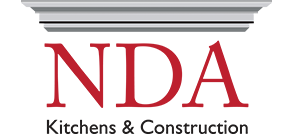All the Different Types of Countertop Edges and the Pros & Cons of Each
Selecting the right countertop material for your kitchen remodel can be a challenging process, but the decisions don’t end there. Your next task is to select the edge design for your countertop. The edge style that you choose will affect the look of your room and may also influence the practicality of your counters.
If you aren’t sure where to start when it comes to sorting through the types of countertop edges, keep reading. In this guide, we’ll help you settle on the right style for your kitchen.
Bullnose
A countertop that is rounded along both its top and bottom edges may have a bullnose finish. This edge style is reminiscent of a letter “U” that’s lying on its side. This shape gives countertops a narrow appearance.
A bullnose finish is ideal from a safety standpoint. It doesn’t have much by way of sharp corners on which you could hurt yourself. Not only that, but the lack of distinct angles makes it less likely that your countertop material will chip when something hits it.
However, bullnose edges are not the easiest to keep clean. Since the rounded edge curves all the way around to the underside of the counter, when you wipe the counters down with a wet rag, you may succeed only in pushing crumbs to the underside of the counter.
Additionally, water spills may follow the curve until they reach your wood cabinetry.
You can see what a bullnose edge looks like in the video below, in which a countertop is cut to a customer’s specifications:
Half Bullnose
If you like the look of a rounded edge but want something that is easier to keep clean, consider a half bullnose. This style is rounded on the top but flat on the bottom. Therefore, crumbs and water are less likely to travel all the way around to the bottom of the counter.
Because the edge is still rounded on top, you aren’t too likely to hurt yourself on this type of countertop edge.
Half bullnoses are usually considered a standard cut, which means that this is often an affordable countertop edge.
Demi Bullnose
Similar to a half bullnose, a demi bullnose features a curved top and a flat bottom. However, the curve on a demi bullnose is much more gradual.
If you want to show off the grain of your countertop material, this is a good way to do so. This style is also good for giving your edges a rounded treatment without making your countertops look thin.
Beveled
Unlike the rounded look of a bullnose countertop, a beveled countertop is all about the angles. This edge style features two 45-degree bends. You can see its shape in the video below:
The angled design of a beveled edge means that this countertop style is an eye-catching feature that reflects a good deal of light. The style works well in both modern and traditional kitchens.
Beveled counters are easy to clean. This cut directs liquid spills to the floor rather than toward your cabinetry, and you can easily wipe crumbs off the edge of the counter.
Beveled edges are usually categorized by the size of their angled face.
Small Beveled
When the bevel cut doesn’t go deep into the countertop’s edge, this is known as a small or narrow bevel. The angled face is usually about 1/4-inch wide, so this can also be called a quarter bevel.
Small bevels have a formal appearance that is best suited to a traditional kitchen design. They can also work well in small kitchen spaces since they add a bit of visual appeal without being an overwhelming design element.
Large Beveled
Sometimes, beveling removes more of a counter’s top corner. The result is a wider angled face, so this style is said to have a large or wide bevel. It can also be called half bevel because the angled face is about 1/2-inch wide.
Large bevels really catch the light. Each face may appear to be a different shade variation of the same color.
Square
As the name implies, square countertops are ones with straight edges. You rarely find countertops with completely straight angles because they’d hurt if you bumped into them, and they’d chip too easily.
Instead, the angles are usually softened just a bit. You may hear an almost-square edge called a roundover or an eased edge.
This is usually a standard design that doesn’t cost extra, so it can be a good way to save money on your remodeling budget. Flat-front edges fit especially well into contemporary kitchen designs but can be a good complement to nearly any look.
Ogee
One of the fancier countertop edges is ogee. Despite its flair, this is a fairly common edge design. An S-shaped curve is its hallmark. The curves of this design can be tight or wide, and the size of the curves have a profound effect on the overall look of an ogee edge.
You can see the basic ogee shape in the video below:
Because of their soft curves, ogee edges are generally safe. They may also be less likely to get chipped than a square edge.
Ogee edges are a very classic style for kitchen countertops. This decorative look is just right for traditional kitchens. It has a place in more contemporary kitchens, too, but it should usually be used sparingly in that setting. For example, you can restrict your use of ogee to just your island countertop.
Keep in mind that there are other decorative edges that you can explore for your countertop as well. These include:
- Triple waterfall: This design features three rounded bumps.
- Dupont: This pattern is similar to a demi bullnose, but it features a 90-degree angle before the beginning of the slope.
- Cove: This design involves a rounded bump that is set inside two 90-degree cutouts.
These are attractive designs, but their involved patterns mean that they can get rather pricey. Plus, edges like this often have narrow crevices that may attract dirt and crumbs and can be hard to clean.
Now that you’re familiar with the basic types of countertop edges, which is your favorite? Keep in mind that you can also request custom cuts and may be able to stack two designs on top of one another for a kitchen look that’s entirely your own.
Let us help you discover the best edge for your kitchen countertops. Call us today to schedule a free consultation.


